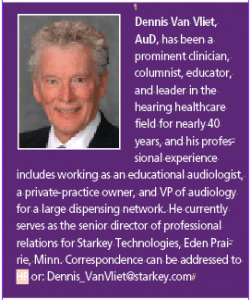Final Word | December 2014 Hearing Review
By Dennis Van Vliet, AuD

No, it wasn’t a theme park character sighting, but a description of the behavior of two patients in a clinic. Both patients had experienced problems with their scheduling. One simply misunderstood when he was supposed to be there, and threw a fit when he learned that he would have to wait a bit until he could be accommodated and worked into the schedule. Obviously, he was “Grumpy.” The other patient showed up very early and because of scheduling and staffing restrictions would have to wait a couple of hours until his scheduled appointment time. The clinic director ended up seeing both patients and told the story about how very different the two patients reacted to their situation.
It turned out that the reception staff at the clinic bobbled the hand-off of “Happy” and didn’t mark him as “arrived” in the patient management computer system when he came back for his scheduled appointment. As a result, his provider didn’t know he was waiting, and he had to wait beyond the couple of hours he had already waited because of the error. When the director finally saw him, she accepted responsibility for the error on behalf of the clinic, and apologized. The patient proceeded to act as the clinic had done him a favor and couldn’t have been more pleasant.
“Grumpy” on the other hand, was greeted similarly but he failed to accept any apology—or any possible responsibility for the appointment misunderstanding—and proceeded to berate the facility and the clinic director before she could get on with his treatment visit.
These situations may become more commonplace in the coming years as practices start to deal with increasing numbers of patients due to demographic changes in the general population. Paper and pencil scheduling systems won’t be efficient enough in very busy practices, and computerized systems will only be as good as the staffers entering the data and interacting with the patients.
How do we prepare for this future? Here is my version of a start:
Setting up an efficient system. Change might be good, but it isn’t necessarily easy. Once a decision is made to change over to a new system, a careful analysis of what is actually needed must be completed. Believe it or not, it is possible to have too much information in a data management system, and the staff may be overwhelmed with duplicative data entry—just the opposite of the goal. If we can think ahead for 10 years, what will be needed to manage appointments, notifications, billing, records, and marketing? What will the volume be, and how will the practice need to change? We cannot foresee the future, but we can make educated predictions and plan accordingly. Our plans should include infrastructure that can grow with the practice and collect the critical data needed to manage.
Setting up an efficient process. Already, practices are complaining that price pressure from alternate distribution systems is pushing the retail value of services and products lower. In order to maintain service at levels that meet expectations, we will need to change our process so that tasks that do not require a licensed professional can be managed by others in the office. We may not only need to change the way we manage our data, but also change the work flow in the office so that the patient is well cared for, but professional time is used more efficiently. Instead of a follow-up appointment taking 30 minutes of professional time, professional time may be a fraction of that, and well-trained staff can care for the patient’s other needs, keeping the service level at the same or better than it would be in a one-person-does-it-all format.
Training staff. Investing the time to train the staff to learn the new and efficient systems may be frustrating because we want to get on with our day-to-day patient care. However, proper training is crucial if changes are to be implemented. A finely tuned process is a pleasure to watch, and a good experience for the staff and the patient. If the process is out of tune due to poor training, nobody gets much pleasure out of the experience.
Dealing with misunderstandings and mistakes. It’s going to happen, no matter how careful we are, no matter how many safeguards are put in place to prevent them: mistakes happen. What to do? Suck it up, apologize for what you can, and do your best to find an agreeable solution.
One trick is to use “we” in talking through the situation and solution so that both the office and the patient are working together to come to a solution. “I’m very sorry, it looks like we didn’t communicate as well as we thought. There are a couple of options open to us, let’s see what works out the best…” If we know we made a mistake, then “I” is the most appropriate pronoun. Own the mistake and the solution.
Protecting your staff and yourself. There are jerks and creeps in the world, and there are lines that shouldn’t be crossed. We don’t know what may trigger an inappropriate action from a patient, but you and your coworkers should have training on how to recognize potentially dangerous situations, how to prevent most of them, and what to do if there is a problem. Human Relations professionals are wonderful resources to consult with to set up a good plan for your practice.
The Final Word? We typically don’t expect to see a parade of characters coming through our doors on any given day. But there are times when we end up with more that our share. Good preparation, efficient and flexible systems, and a dose of humility will help get us through those bad days. Now that I think about it, there should have been a character named “Humble” along with Happy, Grumpy, and the rest to help avoid conflict.
Citation for this article: Van Vliet D. Dealing with Grumpy and Happy, now and in the future. Hearing Review. 2014;21(12):50.





